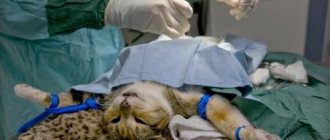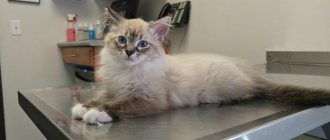After 7-9 months from birth, the cat becomes sexually mature. This means unusual behavior of the pet, loud screams, scratching, noisy fussing at night. Not every owner is happy to see the persistent desire to see a cat, as well as the appearance of offspring. To avoid health problems from unfulfilled cat instincts and difficulties with the placement of numerous kittens, a special operation has been developed - cat sterilization.
Today there are several approaches to this important and sensitive issue of cat health and peace of mind, so let’s dive into the nuances of surgical intervention in the cat’s body in order to prevent the possibility of the animal’s reproduction.
Pros and cons of sterilization
Sterilization, like any surgical process, has advantages and disadvantages.
The arguments “For” include the following arguments:
- a cat is capable of bringing kittens not only annually, but even quarterly, up to 6 kittens at a time. Not all owners want to solve the problem of finding homes for all their children;
- the behavior of an animal during estrus is often inadequate: nighttime guttural cries, lack of appetite, a pervasive smell of urine in the house due to the cat’s desire to mark everything around with its smell;
- if there are babies in the house, a sterilized animal will not bring infection into the house;
- bearing and giving birth to offspring can cost the life of the owner’s beloved cat;
- if a cat is not allowed near the cat during heat, then a large amount of extra hormones appears, which has a detrimental effect on the pet’s psyche;
- increasing the lifespan of a cat.
It is also worth listening to the arguments “against” and drawing conclusions: this is an invasion of the natural course of events planned by nature. It turns out that a person first of all worries about his own peace of mind, and only then about the health of his pet.
The operation may not go as smoothly as we would like; it is difficult for the animal to recover from anesthesia and regain strength.
It is also important to understand that sterilization of a cat is an irreversible process, and the owner will never see kittens from his pet.
Cat sterilization methods
Surgical sterilization of females can be carried out in several ways.
- Removal of ovaries. Suitable for young nulliparous individuals.
- Uterus removal. In this case, the ovaries will continue to produce hormones. This will prevent pregnancy from mating, but estrus and the accompanying behavior will persist.
- Removal of the uterus and ovaries. Used in adult cats that have given birth.
Laparoscopy has become very popular lately. It allows sterilization through a small incision. This operation contributes to minimal trauma and faster and easier rehabilitation.
Castration in cats can be carried out in the following ways:
- Surgical. This method involves surgery, which is performed under general anesthesia.
- Chemical. This method does not require anesthesia, preparation or rehabilitation. However, it has a number of disadvantages such as unreliability, danger of radiation, risk of developing tumors and inflammatory processes
When to spay a cat
global $ads_google;
//data-ad-slot=”2475549904″ $ads_google = empty($ads_google) ? false : true; ?> if ($ads_google == false) {?> $ads_google = true; ?> } ?> At a young age, the operation is easier and more successful: the recommended age of the animal is 8-12 months. The cat is taken to the veterinarian for examination, because it is important to make sure that the pet is physically healthy and developed. Early surgery may cause developmental delays in the animal.
It is also possible to perform sterilization during estrus. But during this period, due to the large amount of hormones in the cat’s body, it will be difficult to recover from anesthesia, and the sutures may take longer to heal than usual. The best time to perform the operation is a couple of weeks before the hunting period or two weeks after it.
If estrus lasts a long time, interrupting only for 2-4 days, then it becomes difficult to find the time. In this case, the pet is sterilized to prevent excessive depletion of its body.
Another important question that concerns some owners: is it possible to sterilize a pregnant cat ? There is a separate name for this process: extirpation of the pregnant uterus. Surgery is performed in emergency cases that require saving the cat's life.
General rules for the use of anthelmintic drugs
Drugs are tablets, pastes, gels or any other form of any medication that is produced by commercial pharmaceutical companies that give them a specific trade name (Cestal Plus, Pratel, Drontal Junior, Dolpac, Milbemax).
Each of them contains at least one substance (for example, Panacur contains an active ingredient called fenbendazole). To the question whether it is necessary to worm a dog before vaccination, the answer is yes, it is necessary, but in compliance with the required dosage. “Dose” is the number of milligrams of a substance per kilogram of animal body weight. For example, the dose of Praziquantel for a dog is 5 mg per kilogram, so for an animal weighing 10 kilograms, 50 mg of Praziquantel should be given. Manufacturers of drugs provide all the information about the amount of drug that should be administered to the dog in the annotation.
Most active substances of anthelmintic drugs have a fairly significant safety margin, that is, their overdose should not cause side effects. Therefore, manufacturers often recommend rounding the number of milligrams to the full volume (eg, tablet, half tablet). Excessive doses of drugs can cause diarrhea in a dog after anthelmintic. Therefore, the dosage should be observed more carefully, following the recommendations in the attached instructions for the medication.
How to deworm a cat
There are many types of deworming medications for cats:
- pills;
- sugar cubes;
- suspensions;
- drops on the withers;
The tablets should be fed to the animal in its pure form or mixed into food. If your cat is not too picky, this option is quite suitable. The most common tablets are Enwire, Milbemax, Troncil, Drontal and some others.
A sugar cube is a kind of healthy treat that the cat eats with pleasure, and you don’t have to worry about how to get your pet to take the medicine. At the moment, Polyvercan is considered the most effective “sugar” against worms.
Prazicide is a liquid suspension that can be given to an animal using a special dispenser syringe. It is enough to secure the cat and quickly pour this liquid into its mouth. Please note that Prazicide is produced in two forms - for adult animals and for kittens.
Profender - drops that are applied to the pet’s withers. If you cannot cope with the animal, it refuses both pills and sugar, try this option. It is also quite effective.
None of the listed remedies should be prescribed to your pet on your own. This should be done by a veterinarian. Only he can choose the right medicine and choose the right dosage based on the age and weight of the cat.
The following tips will help you fight worms in your four-legged friend.
- The medicine should be given in the morning on an empty stomach.
- If you are undergoing treatment, the medicine should be given again 10 days after the first dose.
- The animal must be dewormed 10 days before vaccination, as well as 3 weeks before birth and 3 weeks after.
- For prevention, a cat needs to be dewormed once every 3 months.
- Kittens should be given the medicine at the age of 3 weeks.
- 3 days before the preventive anthelmintic, flea prevention should be carried out.
Follow these tips carefully to keep your cat healthy.
Periodic vaccination makes it possible to protect your pet from many health and life-threatening diseases. To ensure that the introduction of the vaccine does not result in complications, you should properly prepare for the vaccination. One of the necessary conditions for safe vaccination is preliminary treatment of the animal against worms.
How to worm a dog before vaccination? What means are used for this, and how to use them correctly?
Helminth infestation, or helminth infection, is not just a minor everyday nuisance, but a serious disease that can lead to unpleasant consequences. After worm eggs enter the pet’s body (most often this happens through the gastrointestinal tract), the parasites begin to actively multiply, and can live not only in the intestines, but also in other organs - the liver, lungs, heart, brain, etc.
Worms cause loss of appetite, lethargy and other symptoms in cats
In the course of their activity, worms destroy the tissues of internal organs and impair their functioning, reduce the absorption of nutrients and release toxic compounds that are dangerous to the host. In addition, a large number of worms can cause intestinal blockage and even rupture of its walls, especially when it comes to kittens.
- constipation, bloating, flatulence, sometimes vomiting;
- loss of a healthy appearance of the coat - it becomes dull, brittle and disheveled;
- absence or severe increase in appetite;
- itching in the anus, due to which the animal begins to “ride” on its butt and often licks the anus;
- drowsiness and apathy;
- unexplained weight loss.
We suggest you read: Otitis media in cats, symptoms and treatment, prevention
If helminths parasitize the liver, lungs or other organs, the cat will exhibit certain symptoms associated with disruption of their functioning - yellowing of the mucous membranes, cough, discharge from the eyes, etc.
Several types of parasites can live in the body of cats, and each type of infestation has a characteristic clinical course and symptoms.
Table 1. Types of helminthic infestations in cats and their symptoms.
| Form of helminthic infestation | Parasites | Brief description of parasites | Symptoms of helminthic infestation |
| Ascariasis | Ascaris | The most common type of parasite is white roundworms. | Bloating, gastrointestinal disturbances (vomiting, diarrhea, changes in appetite), fragments of parasites or live specimens are found in the stool |
| Nematodosis | Nematode | Round white helminths 3-5 cm long, which can live not only in the intestines, but in the biliary organs and liver | Deterioration of appetite and general health, weight loss (no specific symptoms) |
| Hookworm | Hookworm | Helminths are small in size (2 mm in length), which reproduce quickly and feed on blood | Signs of anemia - apathy, decreased activity, severe thirst, in severe cases alternating constipation and diarrhea, vomiting, blood in stool and vomit. |
| Diphyllobothriasis | Wide tapeworm | A worm that can reach 1-1.5 m in length, sometimes larger, which parasitizes the intestines and destroys the mucous membranes | Gastrointestinal disorders, vomiting and defecation with blood, dull hair, anemia |
| Dipylidiasis | Cucumber tapeworm | A parasite 20-30 cm long, gray in color, with tenacious suction hooks | Bloating, flatulence, apathy, decreased physical activity |
| Alveococcosis | Alveococcus | Small helminths no more than 4 mm long, live in the intestines, are transmitted from infected rodents | Characteristic symptoms of helminthic infestation |
| Paragonimiasis | The causative agent of paragonimiasis | The worms are oval in shape, grow up to 1 cm in length, the larvae enter the intestines or under the skin and penetrate the lungs | Cough, wheezing, loss of appetite, vomiting, diarrhea, fever |
| Opisthorchiasis | The causative agent of opisthorchiasis (cat fluke) | Liver flukes are parasites no more than 0.5 cm, destroy liver tissue, less often settle in the pancreas or gall bladder | Fever, vomiting bile or foam, severe pain, changes in appetite |
| Heartworm | Heartworm | Thin white worms up to 2 cm in length, parasitize the heart and lungs | Cough and other disorders of the respiratory system, loss of appetite, sometimes the invasion is asymptomatic |
There is always a danger to an animal's health due to helminthic infestation, but infection with some types of worms can lead to death - diseases that can cause dire consequences include dirofilariasis and opisthorchiasis.
Roundworms are one of the most common parasites in cats.
The good news for all cat owners is that in mild or moderate stages, helminthic infestations can be treated with special antiparasitic drugs. In addition, to prevent infections and the unpleasant consequences that they can entail, pets need to be regularly wormed for preventive purposes.
Cats need to be wormed several times a year.
The process, which is popularly called anthelmintic, is called deworming in medicine. It must be carried out regularly, since cats are more susceptible to infection with helminths than people - they constantly lick themselves, eat raw fish and meat, and sometimes do not disdain birds and rodents, which are often carriers of dangerous parasites.
Cats need to be wormed or dewormed after reaching the age of one month. If the animal does not leave the house, it is enough to carry out the procedure 3-4 times a year, and for pets that roam freely on the street, it is necessary to increase the frequency of deworming to once a month. Sick animals must be given antiparasitic drugs immediately, in compliance with certain rules and instructions for the medicine.
If your cat has fleas, deworming may not be effective.
Medicines for worms destroy only adult individuals, but are not able to affect the eggs of parasites, so after about 10 days a new generation of helminths grows, which also needs to be destroyed. For serious helminthic infestations, as well as infections in kittens, elderly or weakened animals, treatment should be carried out after consultation with a veterinarian.
Types of cat sterilization
There are several ways to perform the operation: chemical and surgical.
- Tubal occlusion: The cat's fallopian tubes are ligated, eliminating the possibility of pregnancy. Although the intervention is surgical, the reproductive organs are not removed.
- Sterilization is classic - along the white line of the abdomen or an alternative option: through a side incision. In this case, the incision is made on the side, and the muscles are separated using a blunt method. Although the method is less traumatic than the previous one, the uterus is not always completely removed. No seam maintenance is required. An intradermal suture allows the cat to immediately resume its usual lifestyle, gradually restoring its health.
- Sterilization through a very small incision using a surgical hook. A synonym is laparoscopic sterilization, which is not entirely correct, since the peritoneum and skin are also cut, but with a much smaller incision along the length. A disinfected hook is inserted into the wound and used to hook the ligament to the ovary. A ligature is applied and the ovary with a ligament or the entire uterus is removed.
- Laparoscopy as sterilization (ecdoscopic): Thanks to endoscopic technologies, punctures are made in the skin of the abdominal wall and the uterus and ovaries are completely removed. Expensive equipment is used, so the cost of the operation remains high.
- Chemical method or temporary sterilization: a special implant containing a drug is inserted under the animal’s skin. The substance gradually enters the bloodstream and the cat develops a reversible sterilization effect for up to three years.
They choose the appropriate method responsibly: they study veterinary clinics and reviews of them from professional breeders. Saving money and haste are bad advisors in this matter.
Castration of a cat
If during sterilization , which is also called oophorectomy (OE), the ovaries are surgically removed, then during castration both the ovaries and the uterus are removed. Such intervention in the body can be planned or according to indications. There are no contraindications for castration based on the age of the cat.
How is laparoscopic sterilization performed?
After putting the animal under anesthesia, an incision of about 1 cm is made in order to insert a hook into the abdominal cavity. This device moves the intestinal loops and picks up the uterine horn. The uterus along with the ovaries are pulled out through a tiny wound.
This is possible due to the elasticity of cat tissues, especially at a young age.
Then the pulled out organs are strongly pulled out to apply a ligature to the arteries of the ovaries and ligaments, as well as to the horns of the uterus. The process of stretching is very serious, because in fact it is on the verge of breaking the ovarian ligament.
The uterus is cut off and removed, the centimeter incision is sutured: such a seam is not processed or covered with a blanket, since the cat will not be able to lick it.
Preparing a cat on the day of castration
All surgical interventions, with the exception of emergency ones, are always performed on an empty stomach. This need is caused by the prevention of aspiration pneumonia, a very serious complication of surgery that occurs during anesthesia. When the animal relaxes and falls asleep, the liquid contents of the stomach (feed, water, gastric juice), with involuntary vomiting, regurgitation, contraction of the muscles of the esophagus and stomach, can enter the animal’s pharynx, and from there into the respiratory tract, causing severe inflammation of the lung mucosa. Therefore, in order to prepare a cat for castration, it is so important to keep the animal on a fasting diet (10-12 hours), so that all the food has time to be evacuated from the stomach to the intestines.
It is possible and even necessary to give the animal water at this time; water should be removed from access no earlier than two hours in advance to prevent dehydration. Thus, if you signed up for castration of a cat in the morning, you should feed the animal at night and remove its bowl.
If your cat did eat something a few hours before castration surgery, or you suspect this possibility, be sure to notify your veterinarian about this!
Preparing a cat for sterilization
global $ads_google;
//data-ad-slot=”2475549904″ $ads_google = empty($ads_google) ? false : true; ?> if ($ads_google == false) {?> $ads_google = true; ?> } ?> The process of preparing for the operation is taken with the utmost seriousness, because general anesthesia is used.
Be sure to follow all the recommendations of the veterinarian!
Before surgery, tests and ultrasound may be prescribed, and a visit to a cardiologist and therapist is recommended. Such precautions serve to ensure the safety of the animal and the doctor’s confidence in the absence of unpleasant surprises during work. Such precautions are relevant for cats over 10 years of age due to possible pathologies of internal organs.
Before sterilization, the cat should not eat for 8 to 12 hours, and 3 hours before the operation the animal is not allowed to drink, otherwise severe vomiting will occur during the induction of anesthesia. Vomit easily enters the respiratory tract, introducing various types of bacteria.
For everything to go well, you must comply with all the requirements for preparing your pet for anesthesia.
Preparation before sterilization
Direct preparation begins one day before sterilization. It is necessary to give the cat a remedy that will cause its intestines to empty. Most often, Vaseline oil in a volume of 15 ml (tablespoon) is used for this. On the advice of a doctor, they can use a more serious laxative, and sometimes even perform an enema.
For 12 hours before surgery, you should stop feeding the animal, even if the cat is very persistent. This is a very important condition of preparation, which is aimed at making the animal endure anesthesia more easily.
Three hours before sterilization, you can give a few sips of water, after which there is a pause in drinking until the surgical intervention. It is necessary to ensure that all sources of water for the pet are inaccessible. The presence of water in the stomach can lead to involuntary vomiting during anesthesia, which often causes choking.
Sterilizing a cat at home
The procedure for sterilizing a pet at home is no different from the same operation, but in a clinic. Everything is going according to plan:
- Examination of the pet's health, including urine, blood, ECG, and ultrasound tests.
- Preparation for the chosen method of operation: stop feeding your pet 8-12 hours before the due date, and drinking 3 hours before the start of action.
- Introducing an animal into anesthesia.
- Carrying out surgery, suturing.
- The postoperative period consists of caring for the cat immediately after it comes out of anesthesia.
It is important to ensure that your pet does not lick the seam even through the blanket.
Preparing for the cat sterilization procedure
For the success of the upcoming operation, the main factor is the good health of the animal. Sterilization takes place under general anesthesia. To avoid unacceptable consequences in the postoperative period, it is necessary to conduct a full examination of the cat’s health.
Preparation for the surgical procedure includes:
- visiting a veterinary therapist and cardiologist;
- urine and blood analysis;
- blood chemistry;
- Ultrasound of the abdominal cavity;
- echoscopy of the heart.
Based on the test results, the doctor will prescribe appropriate treatment, if necessary, and select anesthesia appropriate to the animal’s health condition. If the cat is healthy, the owner determines the day of sterilization. After surgery, it is important that the animal is under the supervision of an adult family member during the first 24 hours. The date of the operation must be planned so that it is possible not to leave the animal unattended.
Worming
Deworming under normal conditions is carried out at least twice a year. Before sterilization, it is recommended to worm the animal 10 days before. But if the planned deworming was no more than a month ago, there is no need to treat again.
Vaccinations
The pet must be vaccinated. Vaccinations are done to prevent the animal from contracting viral infections. A month before the planned operation, it is necessary to vaccinate your cat.
Nutrition before sterilization
You should consult with your veterinarian on how to properly prepare the animal for the procedure. You can feed your cat before sterilization. 12 hours before sterilization, the animal is excluded from food. To empty the intestines, you can give the animal a tablespoon of Vaseline oil. To completely cleanse the intestines, you can use laxatives or enemas 24 hours before surgery, after consulting with your doctor.
Caring for a cat after sterilization
While a cat is under anesthesia, its body temperature is reduced, so when it comes out of this state, it is important to provide warmth to the animal, using a blanket. The cat is placed on a bed on the floor - the animal may fall or hit itself from higher objects. An absorbent diaper is placed under the animal: urination is not yet controlled.
It is also important to take care of the animal’s eyes: they are open during anesthesia, and to prevent the cornea from drying out, it is better to periodically drip “artificial tears” or regular saline into the eyes.
Since the anesthesia lasts for some time, the cat can jump up and run, jump on furniture, and due to a violation in the coordination of movements, it needs an eye and an eye.
All doctor’s recommendations must be followed impeccably, because the restoration of the cat’s health depends on this.
In order to prevent inflammatory processes in the body, antibiotic therapy may be prescribed. Long-acting antibiotics are used, such as Sinulox, amoxoil, amoxicillin. A pair of injections are required, spaced 48 hours apart.
After sterilization, the cat recovers in about 10 days. Some clinics offer hospitalization of the animal for the entire recovery period under the supervision of specialists.
Feeding the cat
The first drink is given to the animal 5-7 hours after the operation, and after abdominal surgery the cat needs to be sealed off with a pipette. The laparoscopic method is easier to tolerate, and the pussy can drink on its own.
The first feeding is offered after 17-20 hours: the animal may be very hungry. But some fluffies refuse to eat for the first 3 days, but then they quickly begin to eat away.
To prevent a cat's excessive appetite from becoming a cause of obesity, the owner must strictly monitor its diet.
Suture after sterilization
global $ads_google;
//data-ad-slot=”2475549904″ $ads_google = empty($ads_google) ? false : true; ?> if ($ads_google == false) {?> $ads_google = true; ?> } ?> The cat should under no circumstances lick the seam. Over a long week of wearing a blanket, the animal is able to wipe the fabric right through. The seam is inspected daily: there should be no discharge. The ideal condition of the seam means that it is clean and dry.
Treatment of sutures after sterilization includes daily wiping with an antiseptic solution (chlorhexidine, hydrogen peroxide, dioxide are suitable). It will not be superfluous to lubricate the seam with wound-healing ointment.
If there is any discharge from the suture, immediately contact a veterinary clinic.
There are types of sutures that do not require treatment; the doctor who performed the operation will inform you about this.
Sometimes the sutures look somewhat swollen - this is physiological swelling of the tissues, which will subside in 2-3 days.
The stitches are removed after 7-10 days.
Why should the first dewormings be done every 2 weeks?
Most worms live in the duodenum, which is a fairly short section of the small intestine. In this case, there can be up to several hundred worms. Destroying them all at the same time will result in the dead bodies completely blocking the intestines, which will lead to undesirable consequences.
In addition, severe poisoning may result from the decay processes of these organisms. Therefore, it is better to choose a drug that is given in a small dose for several days in a row. This kills the worms slowly but surely. From the practice of veterinarians, it is known that this method is quite safe during the first worming, the side effects are weak and not serious, and often there are none at all.
We suggest you read: The kitten is constipated: causes and what to do?
Many people wonder how often to worm a dog. The first deworming should be carried out on puppies at 2-4 weeks of age, and the next procedure depends on the vaccination schedule. Dog lovers are also interested in how long before vaccination a dog should be wormed. This should be done seven days before the vaccine is administered.
It is also necessary to worm all animals in the house or apartment to avoid the transfer of worms from one dog to another.
You can also contact our site's staff veterinarian, who will respond to them as soon as possible in the comment box below.
The first comprehensive vaccination is carried out at the age of 60-65 days. If the epidemiological situation is unfavorable, the procedure is carried out earlier. After three weeks, the vaccine is given again to produce antibodies.
The puppy's next vaccination occurs at 5-6 months; it is carried out after the animal has completely replaced its milk teeth. At this age, you can additionally vaccinate your dog against rabies. The procedure is then carried out annually and then repeated annually.
Before each trip to the veterinarian, the dog must be given anthelmintic drugs.
If the cat still asks for the cat
The operation was successful, but the cat still wants a cat? There may be several reasons for this:
- tubal occlusion was performed or only the uterus was removed. In this case, the cat will not be able to bear offspring, but the production of sex hormones continues, hence the cat’s desire;
- The lack of professionalism of the veterinarian causes incomplete removal of the ovaries - even a small part left in the body will produce sex hormones. An abandoned ovary can be detected by ultrasound or gonadotropin test. This requires repeat surgery;
- with rare heredity, ectopic ovarian tissue syndrome occurs, when this organ is located in a place not intended by nature, which makes it very difficult for a doctor to find it.
- sex hormones can be produced by the pituitary gland and adrenal glands if the cat has already given birth;
- the presence of a hormone-producing tumor in the animal’s body.
Before starting to worry, wait a month after the operation and only then consult a doctor.
How to prepare a cat for sterilization
Typically, the veterinarian who castrates animals tells you in advance how to prepare your pet for this important procedure, what to do after the operation, and other points. If you do decide to take your pet to a veterinary clinic, you should know how to prepare your cat for sterilization. You don't have to take any special actions. It is necessary to provide the animal with a 12-hour fasting diet before surgery, and not even give water in the morning. Such measures are necessary in order to prevent vomiting that may occur due to the effects of anesthesia.
As you can see, everything is quite simple. Perhaps the most difficult moment is for the owners themselves, who are worried about their pet, to mentally prepare for the operation. Don't worry, an experienced veterinarian will do everything right.











